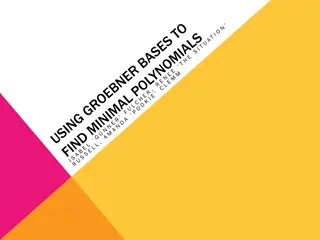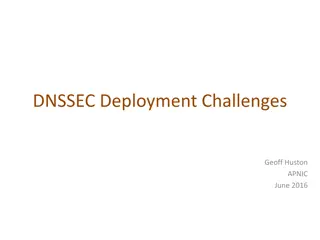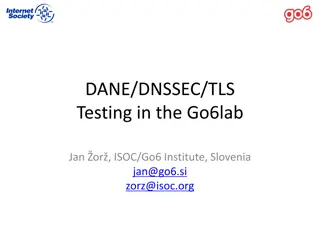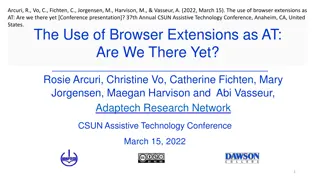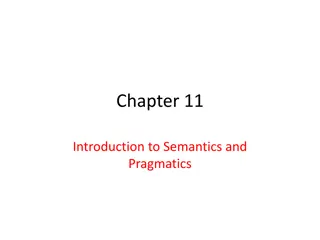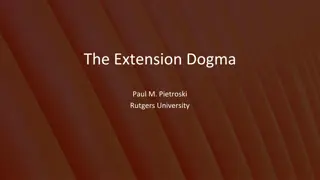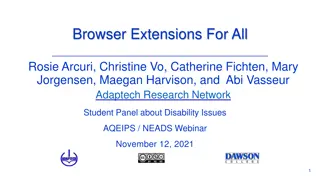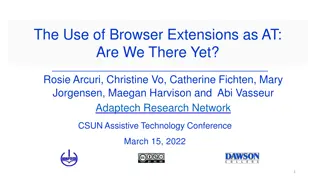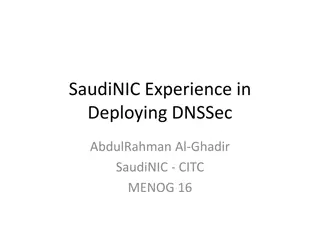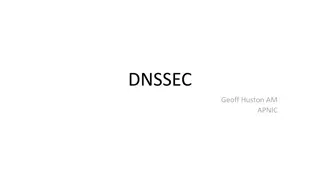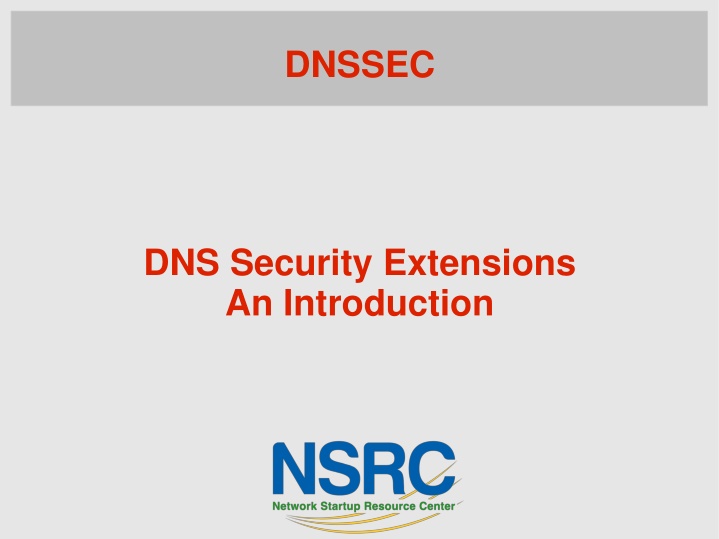
Introduction to DNS Security Extensions and DNSSEC Concepts
"Learn about DNS security extensions such as DNSSEC, zone file formats, record structures, and DNSSEC concepts including data authenticity, integrity, and setting up secure zones. Understand how DNS trust models have changed to ensure verifiability and integrity in the domain name system."
Download Presentation

Please find below an Image/Link to download the presentation.
The content on the website is provided AS IS for your information and personal use only. It may not be sold, licensed, or shared on other websites without obtaining consent from the author. If you encounter any issues during the download, it is possible that the publisher has removed the file from their server.
You are allowed to download the files provided on this website for personal or commercial use, subject to the condition that they are used lawfully. All files are the property of their respective owners.
The content on the website is provided AS IS for your information and personal use only. It may not be sold, licensed, or shared on other websites without obtaining consent from the author.
E N D
Presentation Transcript
DNSSEC DNS Security Extensions An Introduction
DNS reminders ISC BIND zone file format is commonly used, and we will use this notation here. zone. SOA nsX.zone. hostmaster.zone. ( 2009022401 ; serial 1d ; refresh 12h ; retry 1w ; expire 1h ) ; neg. TTL zone. NS ns.zone. NS ns.otherzone. zone. MX 5 server.otherzone. www.zone. A 1.2.3.4 ...
DNS reminders Record structure: NAME [TTL] TYPE DATA (type specific) -------------------------------------------- host.zone. 3600 A 10.20.30.40 sub.zone. 86400 MX 5 server.otherzone.
DNS reminders Multiple resource records with same name and type are grouped into Resource Record Sets (RRsets): mail.zone. MX 5 server1.zone. mail.zone. MX 10 server2.zone. RRset server1.zone. A 10.20.30.40 server1.zone. A 10.20.30.41 server1.zone. A 10.20.30.42 RRset server1.zone. AAAA 2001:123:456::1 server1.zone. AAAA 2001:123:456::2 RRset RRset server2.zone. A 11.22.33.44
DNSSEC in a nutshell Data authenticity and integrity by signing the Resource Records Sets with a private key Public DNSKEYs published, used to verify the RRSIGs Children sign their zones with their private key Authenticity of that key established by parent signing hash (DS) of the child zone's key Repeat for parent... Not that difficult on paper Operationally, it is a bit more complicated
Concepts New Resource Records (DNSKEY, RRSIG, NSEC/NSEC3 and DS) New DNS message options (CD, AD, DO) Setting up a Secure Zone Delegating Signing Authority
DNSSEC concepts Changes DNS trust model from one of open and trusting to one of verifiable Use of public key cryptography to provide: Authentication of origin Data integrity Authenticated denial of existence No attempt to provide confidentiality (NO encryption) DNSSEC does not normally place computational load on the authoritative servers ( != those signing the zone) No modifications to the core protocol Can coexist with today's infrastructure (EDNS0)
DNSSEC concepts Build a chain of trust using the existing delegation- based model of distribution that is the DNS We don't sign the entire zone; we sign an RRset . ORG NSRC WS Note: the parent DOES NOT sign the child zone. The parent signs a pointer (hash) to the key used to sign the data of child zone (DS record)
DNSSEC: new RRs Adds five new DNS Resource Records*: 1DNSKEY: Public key used in zone signing operations. 2RRSIG: RRset signature 3NSEC & 4NSEC3: Returned as verifiable evidence that the name and/or RR type does not exist 5DS: Delegation Signer. Contains the hash of the public key used to sign the key which itself will be used to sign the zone data. Follow DS RR's until a trusted zone is reached (ideally the root). *See Geoff Huston's discussion at http://ispcolumn.isoc.org/2006-08/dnssec.html
DNSSEC: DNSKEY RR OWNER FLAGS PROTOCOL ALGORITHM TYPE MYZONE. 600 DNSKEY 256 3 5 ( AwEAAdevJXb4NxFnDFT0Jg9d/jRhJwzM/YTu PJqpvjRl14WabhabS6vioBX8Vz6XvnCzhlAx KEY ID ...) ; key id = 5538 - FLAGS determines the usage of the key (more on this...) - PROTOCOL is always 3 (DNSSEC) - ALGORITHM can be: 0 reserved 1 RSA/MD5 (deprecated) 2 Diffie/Hellman 3 DSA/SHA-1 (optional) 4 reserved http://www.iana.org/assignments/dns-sec-alg-numbers/dns-sec-alg-numbers.xml PUBLIC KEY (BASE64) 5 RSA/SHA-1 (mandatory in validator) 8 RSA/SHA-256 10 RSA/SHA-512 13 ECDSAP256SHA256 14 ECDSAP384SHA384
DNSSEC: Two keys, not one... There are in practice at least two DNSKEY pairs for every zone. Originally, one key-pair (public, private) defined for the zone: private key used to sign the zone data (RRsets) public key published (DNSKEY) in zone DNSSEC works fine with a single key pair... Problem with using a single key: Every time the key is updated the, DS record corresponding to the key must be updated in the parent zone as well Introduction of Key Signing Key (flags = 257)
DNSSEC: KSK and ZSK Key Signing Key (KSK) pointed to by parent zone in the form of DS (Delegation Signer). Also called Secure Entry Point used to sign the Zone Signing Key (ZSK) Zone Signing Key (ZSK) signed by the Key Signing Key used to sign the zone data RRsets This decoupling allows for independent updating of the ZSK without having to update the KSK, and involve the parent less administrative interaction. DSKSK KSK signs ZSK signs RRsets
DNSSEC: Resource Record SIGnature RRset signed using ZSK test.myzone. 600 A 1.2.3.4 test.myzone. 600 A 2.3.4.5 2 1 TYPE COVERED ALGO # LABELS ORIG. TTL TYPE SIG. EXPIR. test.myzone. 600 RRSIG A 5 2 600 20090317182441 ( 20090215182441 5538 myzone. SIGNER NAME KEY ID rOXjsOwdIr576VRAoIBfbk0TPtxvp+1PI0XH p1mVwfR3u+ZuLBGxkaJkorEngXuvThV9egBC ... ) SIGNATURE = SIG( + ) SIG. INCEP. RRset RRSIG-DATA SIG
DNSSEC: RRSIG Typical default values (not a standard, but BP): Signature inception time is 1 hour before Signature expiration is 30 days from now Proper timekeeping (NTP) is required What happens when the signatures run out ? SERVFAIL... Your domain effectively disappears from the Internet for validating resolvers Note that the keys do not expire. Therefore, regular re-signing is part of the operations process (not only when changes occur) Not all RRsets need be resigned at the same time
DNSSEC: NSEC/NSEC3 Proof of non-existence using NSEC & NSEC3 NSEC provides a pointer to the Next SECure record in the chain of records. there are no other records between this one and the next , signed. The entire zone is sorted lexicographically: myzone. NS ... ace.myzone. A ... bob.myzone. CNAME ... cat.myzone. A ... eel.myzone. MX ...
DNSSEC: NSEC/NSEC3 myzone. 10800 NSEC test.myzone. NS SOA RRSIG NSEC DNSKEY myzone. 10800 RRSIG NSEC 5 1 10800 20090317182441 ( 20090215182441 5538 myzone. ZTYDLeUDMlpsp+IWV8gcUVRkIr7KmkVS5TPH KPsxgXCnjnd8qk+ddXlrQerUeho4RTq8CpKV ... ) Last NSEC record points back to the first. Problem: Zone enumeration (walk list of NSEC records) Public DNS shouldn't be used to store sensitive information But policy requirements vary.
DNSSEC: NSEC/NSEC3 If the server responds NXDOMAIN: One or more NSEC RRs indicate that the name (or a wildcard expansion) does not exist If the server's response is NOERROR: ...and the answer section is empty The NSEC proves that the TYPE did not exist
DNSSEC: NSEC/NSEC3 What about NSEC3 ? We won't get into details here: Don't sign the name of the Next SECure record, but a hashof it Still possible to prove non-existence, without revealing name. This is a simplified explanation. RFC 5155 covering NSEC3 is long! Also introduces the concept of opt-out (see section 6 of the RFC) for delegation-centric zones Don't bother signing RRsets for delegations which you know don't implement DNSSEC.
DNSSEC: DS Delegation Signer Hash of the KSK of the child zone Stored in the parent zone, together with the NS RRs indicating a delegation of the child zone The DS record for the child zone is signed together with the rest of the parent zone data NS records are NOT signed (they are a hint/pointer) Digest type 1 = SHA-1, 2 = SHA-256 myzone. DS 61138 5 1 F6CD025B3F5D0304089505354A0115584B56D683 myzone. DS 61138 5 2 CCBC0B557510E4256E88C01B0B1336AC4ED6FE08C826 8CC1AA5FBF00 5DCE3210 digest = hash( canonical FQDN on KEY RR | KEY_RR_rdata)
DNSSEC: DS Two hashes generated by default: 1 SHA-1 2 SHA-256 3 GOST R 34.11-94 4 SHA-384 Mandatory support for validator Mandatory support for validator Optional Optional New algorithms are being standardised This will continue over time as algorithm recommendations change
DNSSEC: new fields/flags Updates DNS protocol at the packet level Non-compliant DNS recursive servers should ignore these: CD: Checking Disabled (ask recursing server to not perform validation, even if DNSSEC signatures are available and verifiable, i.e.: a Secure Entry Point can be found) AD: Authenticated Data, set on the answer by the validating server if the answer could be validated, and the client requested validation A new EDNS0 option DO: DNSSEC OK (EDNS0 OPT header) to indicate client support for DNSSEC options
Security Status of Data (RFC4033 5 & 4035 4.3) Secure Resolver is able to build a chain of signed DNSKEY and DS RRs from a trusted security anchor to the RRset Insecure Resolver knows that it has no chain of signed DNSKEY and DS RRs from any trusted starting point to the RRset Bogus Resolver believes that it ought to be able to establish a chain of trust but for which it is unable to do so May indicate an attack but may also indicate a configuration error or some form of data corruption Indeterminate No trust anchor to indicate if the zone and children should be secure. Resolver is not able to determine whether the RRset should be signed.
Signature expiration Signatures are per default 30 days (BIND) Need for regular resigning: To maintain a constant window of validity for the signatures of the existing RRset To sign new and updated Rrsets Use of jitter to avoid having to resign all expiring RRsets at the same time The keys themselves do NOT expire... But they may need to be rolled over...
Key Rollovers Try to minimise impact Short validity of signatures Regular key rollover Remember: DNSKEYs do not have timestamps the RRSIG over the DNSKEY has the timestamp Key rollover involves second party or parties: State to be maintained during rollover Operationally expensive RFC5011 + BIND support See http://www.potaroo.net/ispcol/2010-02/rollover.html
So, what does DNSSEC protect ? zone file (text, DB) MASTER DATA caching resolver (recursive) dynamic updates STUB resolver Zone Transfer SLAVES SLAVES VECTORS ATTACK spoofing master (routing/Do S) man in the middle cache poisonin g corrupte d data modified data spoofed updates (TSIG ) PROTECTION BY DNSSEC
What doesn't it protect ? Confidentiality The data is not encrypted Communication between the stub resolver (i.e: your OS/desktop) and the caching resolver. For this, you would have to use TSIG, SIG(0), or you will have to trust your resolver It performs all validation on your behalf Still need to do validation yourself if you don't trust your upstream's nameservers








